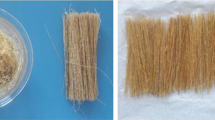Abstract
The robustness and hardness of biofiber composites produced of bamboo and tamarind fibers were investigated in this study. In contrast to synthetic fibers, these fibers are inexhaustible, lightweight, cost-effective, and biodegradable. While natural fibers have several advantages over synthetic fibers, one disadvantage is that they are hydrophilic. The hydrophilic aspect of fibers makes it difficult for the matrix and fibers to fuse well. So the fibers are chemically processed with sodium hydroxide, potassium permanganate, acrylic acid, and benzene diazonium chloride to improve their cohesiveness. These treatments change the surface texture and biocomposition, allowing fibers and resin to adhere properly. The fabrication process is completed using the hand layup method. The specimens were made with varying weight ratios of fiber composition (10, 20, 30, 40, and 50%). The specimens were tested for strength using ASTM standards. Chemical procedures changed the fiber structure and improved the composite’s performance, according to the study. 40% fiber weight composite specimen handled with benzene diazonium chloride had superior strength properties to untreated and chemically handled fibers. The moisture content of untreated and treated fibers was tested, and the results showed that the fibers treated with benzene diazonium chloride had less moisture. The dielectric strength test results revealed that 40% wt of fiber treated with benzene diazonium chloride has a higher dielectric strength.
Access this chapter
Tax calculation will be finalised at checkout
Purchases are for personal use only
Similar content being viewed by others
References
Venkatesha Prasanna G, Venkata Subbaiah K, Varada Rajulu A (2012) Chemical resistance, impact, flexural, compressive properties and optimization of fibers of natural fibers reinforced blend composites. Scholarly J Eng Res 1(6):85–89
Kalia S, Kaith BS, Kaur I (2009) Pretreatments of natural fibres and their application as reinforcing material in polymer composites—a review. Polymer Eng Sci 49:1253–1272
.Venkatesha Prasanna G, Sunil Kumar V, Srilekha R, Sri Harsha AVN, Sai Abhi Chandan V (2021) Hybridization and influence of chemical treatment on the morphology and optimization of composites, Elsevier, Materials today proceedings, 4833–4837
Alamgi MK, Monimul MH, Islam RM, Bledzki AK (2010) BioResources 5:1618–1625
Rahman MR, Islam MN, Huque MM, Hamdan S, Ahmed AS (2010) BioResources 5:854
Punyamurth R, Sampath Kumar D, Bennehalli B, Badyankal P, Vekateshappa SC (2014) Surface modification of abaca fiber by benzene diazonium chloride treatment and its influence on tensile properties of abaca fiber reinforced polypropylene composites. CienciaTechnologia dos materials 26(2):142–149
Composites and its recycle. J Biol Sci 7:393-396 (2007)
Yu T, Ren J, Li S, Yuan H, Li Y (2010) Effect of fibre surface-treatments on the properties of poly (lactic acid)/ramie compo-sites. Composites Part A: Appl Sci Manuf 41:499–505
Venkatesha Prasanna G, Sri Harsha AVN, Srilekha R, Sunil Kumar V, Sai Abhi Chandan V (2020) Chemical treatment and fiber length,their effecton the mechanical properties of blended composites, Elsevier, materials today proceedings,4862–4866
John MJ, Anandjiwala RD (2008) Recent developments in chemical modification and characterization of natural fiber-reinforced composites. Polym Compos 29:187–207
Author information
Authors and Affiliations
Editor information
Editors and Affiliations
Rights and permissions
Copyright information
© 2022 The Author(s), under exclusive license to Springer Nature Singapore Pte Ltd.
About this paper
Cite this paper
Venkatesha Prasanna, G., Sri Harsha, A.V.N., Sunil Kumar, V., Srilekha, R. (2022). Mechanical Testing and Optimization of Bamboo and Tamarind Fiber Composites. In: Dave, H.K., Dixit, U.S., Nedelcu, D. (eds) Recent Advances in Manufacturing Processes and Systems. Lecture Notes in Mechanical Engineering. Springer, Singapore. https://doi.org/10.1007/978-981-16-7787-8_52
Download citation
DOI: https://doi.org/10.1007/978-981-16-7787-8_52
Published:
Publisher Name: Springer, Singapore
Print ISBN: 978-981-16-7786-1
Online ISBN: 978-981-16-7787-8
eBook Packages: EngineeringEngineering (R0)




